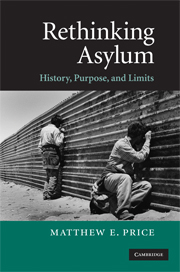Book contents
- Frontmatter
- Contents
- Acknowledgments
- Introduction
- Chapter 1 Recovering Asylum's Political Roots
- Chapter 2 Promoting Political Values through Asylum
- Chapter 3 What is “Persecution”?
- Chapter 4 Persecution by Private Parties
- Chapter 5 Asylum, Temporary Protection, and the Refugee Policy Toolkit
- Chapter 6 Restrictions on Access to Asylum
- Conclusion
- Bibliography
- Index
Chapter 6 - Restrictions on Access to Asylum
Published online by Cambridge University Press: 26 January 2010
- Frontmatter
- Contents
- Acknowledgments
- Introduction
- Chapter 1 Recovering Asylum's Political Roots
- Chapter 2 Promoting Political Values through Asylum
- Chapter 3 What is “Persecution”?
- Chapter 4 Persecution by Private Parties
- Chapter 5 Asylum, Temporary Protection, and the Refugee Policy Toolkit
- Chapter 6 Restrictions on Access to Asylum
- Conclusion
- Bibliography
- Index
Summary
The Introduction identified two trends that have marked asylum policy over the last fifteen years. The first is the broadening of the substantive grounds for asylum eligibility. Court decisions have granted asylum to many classes of applicants who historically have been excluded – including those fleeing ethnic conflict, domestic violence, and abusive cultural practices like female genital mutilation. Those in support of a humanitarian approach to asylum have advocated further extending the grounds for eligibility beyond those fleeing persecution, to encompass people in need of protection from other sorts of harms, like famine, environmental catastrophe, generalized violence, and even extreme poverty. The bulk of this book has argued that there are good reasons – both theoretical and practical – for preserving asylum's traditional focus on assisting persecuted people, as opposed to other needy people who can be assisted through other types of refugee policy.
The second trend of the last fifteen years has been increasingly draconian measures that have made it difficult for would-be asylum seekers to file their claims. These include, as we shall see, the erection of barriers designed to make it more difficult for asylum seekers to enter the territory of an asylum state; the imposition of a variety of procedural rules that make it more difficult for asylum seekers to apply for asylum if they are able to enter the territory of an asylum state; and the denial of benefits and the use of detention to further discourage would-be applicants from making claims.
- Type
- Chapter
- Information
- Rethinking AsylumHistory, Purpose, and Limits, pp. 200 - 244Publisher: Cambridge University PressPrint publication year: 2009



